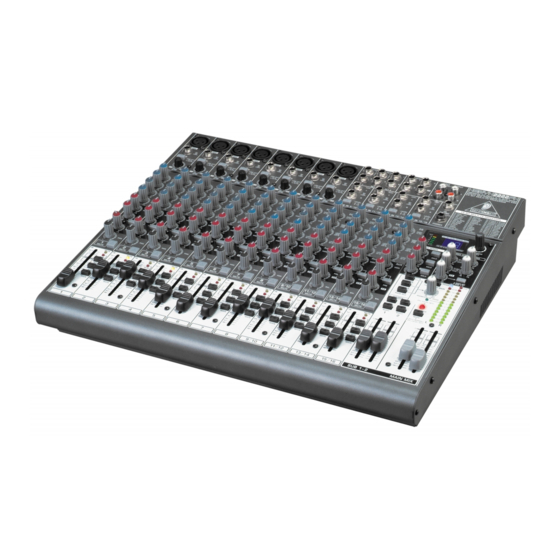
Table of Contents
Advertisement
Quick Links
Advertisement
Table of Contents

Summarization of Contents
1. Introduction
1.1 General mixing console functions
Explains the three main functions of a mixing console: signal processing, level setting, and frequency correction.
1.2 The user's manual
Guides on how to use the manual, its structure, and where to find additional information.
1.3 Before you get started
Covers shipment inspection, initial operation guidelines, and the importance of online registration.
2. Control Elements and Connectors
2.1 Mono channels
Details the controls and connections for mono input channels, including inputs, EQ, and sends.
2.1.1 Microphone and line inputs
Explains the XLR mic input, phantom power, and 1/4" line input for mono channels.
2.1.2 Equalizer
Describes the 3-band semi-parametric equalizer found on mono input channels.
2.1.3 Monitor and effects busses (Aux sends)
Explains routing signals to aux sends for monitor mixes and external effects processing.
2.1.4 Routing switch, PAN, SOLO and channel fader
Details controls for signal routing, panning, soloing, and channel volume adjustment.
2.2 Stereo channels
Covers the controls and connections specific to stereo input channels.
2.2.1 Channel inputs
Explains stereo line inputs, level switches, and special features on certain stereo channels.
2.2.2 Equalizer stereo channels
Describes the stereo EQ section for stereo channels, offering enhanced stereo imaging.
2.2.3 Aux sends stereo channels
Explains how aux sends function on stereo channels, noting they are summed to mono.
2.2.4 Routing switch, solo and channel fader
Details routing, solo, and fader controls for stereo channels, similar to mono channels.
2.3 Interface panel and main section
Discusses the main section controls, signal routing, and monitoring.
2.3.1 MON control, aux sends 1, 2 and 3 (FX)
Explains the master controls for monitor and FX aux sends, including dedicated monitor path.
2.3.2 Aux send jacks
Details the physical jacks for routing aux send signals to external devices or monitor systems.
2.3.3 Stereo aux return connectors
Describes the connectors for returning processed signals from external effects devices.
2.3.4 The monitor section of the 1832FX
Highlights the dedicated monitor output and MON SEND fader on the 1832FX model.
2.3.5 Stereo aux return control
Explains the controls for stereo aux returns and their use for effects or additional inputs.
2.3.6 Supplement to 1832FX
Details additional routing options for the AUX RETURN FX on the 1832FX model.
2.3.7 XPQ Surround function (1832FX only)
Explains the XPQ surround sound effect for widening the stereo image.
2.3.8 CD/Tape input, CD/tape output
Describes the RCA connectors for tape/CD inputs and outputs for line-level signals.
2.3.9 Lamp socket (2442FX only)
Mentions the BNC socket for connecting a gooseneck lamp on the 2442FX model.
2.3.10 Level meter and monitoring
Explains how to use level meters and monitor signals via control room and headphone outputs.
2.3.11 Subgroups and main mix fader
Explains the subgroup and main mix faders for controlling output levels and routing.
3. Graphic 9-Band Equalizer (1832FX only)
EQUALIZER
Describes the function of the graphic equalizer switch to activate the EQ.
MAIN MIX/MONITOR
Explains how the graphic equalizer can be routed to the main mix or monitor path.
4. Digital Effects Processor
24-Bit Multi-Effects Processor
Details the built-in effects module, its presets, and how to use it with aux sends.
5. Rear Panel Connectors
5.1 Main mix outputs, insert points and control room outputs
Describes rear panel outputs, insert points, and control room output connections.
5.2 Subgroup outputs
Explains the unbalanced subgroup output connections for routing channel groups.
5.3 Inserts
Details how to use insert points for processing channel signals with external equipment.
5.4 Direct outputs (2442FX only)
Describes direct outputs for recording individual mono channels on specific models.
5.5 Voltage supply, phantom power supply and fuse
Covers power connection, phantom power activation, and fuse replacement information.
6. Installation
6.1 Rack mounting
Instructions for mounting the mixing console in a standard 19" rack.
6.2 Cable connections
Guidance on connecting various audio and control cables to the mixer.
6.2.1 Audio connections
Explains wiring for audio signals using XLR, mono, and stereo connectors.
7. Specifications
Microphone inputs (XENYX Mic Preamp)
Technical specifications for the XENYX microphone preamps, including EIN and frequency response.
Distortion (THD+N)
Specifications related to total harmonic distortion plus noise for various inputs.
Frequency response
Technical specifications detailing the frequency response of microphone and line inputs.
Stereo inputs
Technical specifications for stereo line inputs, including type, impedance, and max input level.
EQ mono channels
Specifications for the 3-band equalizer on mono channels, detailing frequency ranges and cut/boost.
EQ stereo channels
Specifications for the stereo equalizer on stereo channels.
Aux sends
Technical specifications for aux send connections, including type, impedance, and max output level.
Stereo aux returns
Technical specifications for stereo aux return connections, including type and impedance.
8. Warranty
§ 1 Other Warranty Rights and National Law
Outlines the buyer's statutory rights and how national law interacts with the warranty.
§ 2 Online Registration
Instructions for registering new BEHRINGER equipment online for efficient warranty service.
§ 3 Warranty
Details BEHRINGER's warranty policy, covering mechanical and electronic components for one year.
§ 4 Return Authorization Number
Procedure for obtaining warranty service, including contacting BEHRINGER and obtaining an authorization number.
§ 5 Warranty Regulations
Specifies rules, exclusions, and conditions for warranty claims, including damage and wear.
§ 6 Warranty Transferability
States that the warranty is extended exclusively to the original buyer and is not transferable.
§ 7 Claim for Damages
Limits BEHRINGER's liability for consequential damages and total liability to the invoiced product value.








Need help?
Do you have a question about the 1832FX and is the answer not in the manual?
Questions and answers